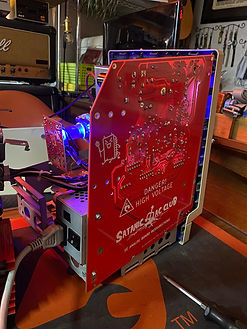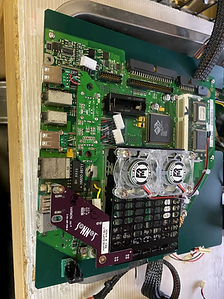
Macintosh SE/30
The Macintosh SE/30 is probably the most beloved compact Mac of all time. Even if you’re lucky enough to get your hands on one, the dream often comes with heartbreak. Battery bombs, leaking electrolytic capacitors eating away traces, flaky connectors, broken sound, SCSI errors—you name it. Nobody escapes these issues. Most repairs can be managed once you get it to boot, but sometimes a logic board is simply beyond saving. And yet, when you do get a working SE/30, how does it feel? Pure stability, a comforting sense of reliability, and support for a massive 128 MB of RAM—an absurd amount for its time. Add in the wide range of accelerators and graphics cards available, and you had a machine that could stand shoulder-to-shoulder with any 68040 desktop Mac.
I could fill pages with all the experiences tied to this machine, and I still couldn’t cover it all. One day I’ll circle back and add more here. For now, if you’re thinking of buying an SE/30 with little knowledge, I’d strongly suggest one that’s been tested and maintained. If you buy “as-is,” you might want to choose another Macintosh instead—SE/30 repairs are notoriously difficult, and even experts find themselves stumped from time to time.
Recommended Hardware Mods
Logic Board and Analog Board
The new SE/30 logic board has even been recreated from scratch by Bolle in Germany through reverse engineering. It’s open-source, and if your original board is too far gone, you can transfer the components and build a brand-new one.
I’ve done this twice myself, and both boards worked perfectly—but don’t underestimate the skill involved. I’ve seen plenty of failed attempts in the forums. That said, even failure is valuable experience. Nobody is good at everything, and knowing your own limits is important. If you want to attempt this, make sure you’ve got plenty of practice with other kits first.
As for the analog board, I also reverse engineered and recreated, which I named SE Analog Board Resurrections. Compared to the logic board, it’s a much simpler build: through-hole soldering only, making it a friendlier project.
ROM and RAM Cards
If you want to max out the SE/30’s RAM at 128 MB, you’ll need eight 16 MB SIMMs. You can sometimes find these on eBay or from OWC. The OWC sticks use 3.3V chips with regulators, making them a bit taller than usual—they collide with the SE/30’s chassis, meaning you’ll have to file down the reinforcing bumps inside the frame.
That said, even 32 MB was enormous back then, so eight 4 MB SIMMs are plenty for running any software with 32bit "clean". You can even make your own 4 MB SIMMs by converting 16 MB 72-pin SIMMs into sets of 30-pin modules—check out Our 4MB SIMM DIY Kit project if you’re curious. Please check out my friend Colin's YouTube video (15:00) here on these topics as well. JDW and Branchus Creation also made some great videos, so thanks to them. I highly recommend these if you're thinking about trying your hand at making something yourself with a soldering iron, as it will give you the exciting experience of seeing your own cards work in your own Mac! More details on my blog here.
Old-school enthusiasts once swapped in IIfx ROMs for 32-bit clean operation without MODE32 extension, but research later showed the IIfx and IIsi actually share the same ROM. On the other hand, The SE/30, IIx, and likely IIcx all share the same “dirty” ROM as well. Around 2005, Mac hackers discovered the IIsi ROM was particularly useful, sparking a wave of third-party ROM SIMMs with added features. The most famous and pioneer of these came from BMOW's ROM-inatorII. For years the dedicated programmer was discontinued, but recently CayMac began selling them again. Before that, we designed a SMC ROM SIMM that could be flashed with common programmers like the Xgecu T48. With these ROMs, you can boot 32-bit clean and use all 128 MB of RAM without MODE32. The best combo is a hacked IIsi-based ROM card paired with high-capacity RAM.
Then we created an app called "Crucible(<-Download here)" to make it easier for users to program the ROM SIMM. Check out our videos here (Part 1/ Part 2) and Colin's instructional video here *from 16:28.
I would also like to express my hat off to Steve Chamberlin and the other hackers Gamba, Jeff Walther (trag), Doug Brown (dougg3) and Rob Braun, who worked so hard to analyze the ROM in the early stages...
If your ROM socket is too unreliable, you may need to replace it—but even then, board warping can cause bad connections. In that case, our PDS ROM card is a simple solution (Colin's instructional video here). It runs the same IIsi-based ROMs as SIMMs and avoids the socket problem entirely.
BlueSCSI
On 68k Macs, BlueSCSI is a lifesaver, and the SE/30 is no exception. It doesn’t just emulate hard drives—it can also handle CD-ROMs, even SCSI floppies. Pair it with a Wi-Fi model, and suddenly your SE/30 can browse the web through vintage Mac-friendly browsers, showing up as a SCSI Dynaport device.
You can mount BlueSCSI inside with the included brackets, or use rider cards for quick testing without cables. My SCSI-Rider is especially useful if you’re constantly swapping boards in and out for diagnostics, as I described on the SE page.
Expansion Cards
Thanks to its high-bandwidth PDS slot, the SE/30 had more expansion cards than any other compact Mac, and hackers are still experimenting with it today. Among CPU upgrades, Interware’s Booster30 with a 50 MHz 68030 is legendary.
It doesn’t even need drivers, and it works with IIsi-based ROM SIMMs if you swap in a modified GAL chip by my friend Zigzagjoe's hack. That makes it the most elegant upgrade of its class.
*I'm not sure if it's okay to share the GAL chip program, so please ask him.
With adapters, you can even run accelerators like the Turbo040 and Carrera040—though in practice, I still prefer 68030 upgrades for usability.
Graphics cards included the Interware Vimarge, RasterOps, Radius, and the popular Micron Xceed Gray-Scale. The Xceed is often praised, but since it only adds grayscale and not VGA output, I never found much use for it. LAN cards were once a must-have, but with BlueSCSI Wi-Fi, those are less relevant today.
One of the SE/30s in my collection has a green monitor installed, which can be confusing, but this is definitely an SE/30 screen! The Carrera040 is known for being overclockable, so I gave it a try. Of course, I used our small overclocking device, Spicy O'Clock!
I was able to get it to operate stably at 45.36MHz...
Shell Case Mods
One of the most famous SE/30 case mods comes from my friend Mark Jozaitis and his MacEffects team, who created the clear SE/30 shells. These aren’t just novelty cases—unlike the original, which hides messy reinforcements inside, the transparent shell had to be redesigned beautifully both inside and out. The result is stunning, and I’ve seen many YouTubers rebuild their dream SE/30s inside them. Colin from "This Does Not Compute" is one of them—he even mounted a BlueSCSI V1 with Beleth’s Drum for a clever storage solution(18:25).
SE/30 from Another World
This is something I built back when I was younger. The SE/30’s logic board was dead, and the iMac’s analog board had failed—so what do you do? I decided to merge the two into one machine. At the time, my kids were still little, so this project carries a lot of memories for me. For years it sat tucked away in the closet, and I thought I’d never use it again, but a few years ago I carefully rebuilt it. You can find the details here.
Inside, it’s essentially a Macintosh G3 running at 666 MHz. It has USB and FireWire, but of course still supports ADB as well. About 20 years ago, I used it as a printer server. It can boot into Mac OS X, but since it’s a Rev. C iMac board, the graphics aren’t accelerated and performance is painfully slow. Instead, I mainly run Mac OS 9.2 on it.
I built it with great care, so even under close inspection it’s presentable. That’s why I’d love to bring it to a computer festival one day and show it off.
Why I Keep Coming Back to the SE/30...
After the Color Classic, the SE/30 is the model I own the most of. I can’t explain why it captivates me so much, but it’s undeniably special. In Japan, every university lab seemed to have one. At the music store where I worked, the Classic II was the “new model,” but the SE/30’s higher price and sharper design gave it an aura of prestige. Back then, I didn’t crave ownership—I just used Macs as tools. But looking back years later, I realized I wanted to return to that world. At the very center of it all is the SE/30!
















